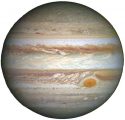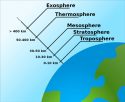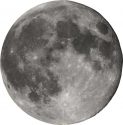 The Sun is one of the Stars that you see in the skies during night time, but it is the only star in our solar system. All the planets, including our Earth, orbit around the sun due to its immense gravity. Also, life is possible on Earth due to the presence of the Sun.
The Sun is one of the Stars that you see in the skies during night time, but it is the only star in our solar system. All the planets, including our Earth, orbit around the sun due to its immense gravity. Also, life is possible on Earth due to the presence of the Sun.
There are billions of stars in our galaxy and the Sun is categorized as a smaller star – also called a yellow dwarf. The sun is the largest and most massive object in our solar system which accounts for 99.86% of the total mass of our solar system. The planets, moons, asteroids, and comets together make-up around 0.14% of the solar system.
Formation
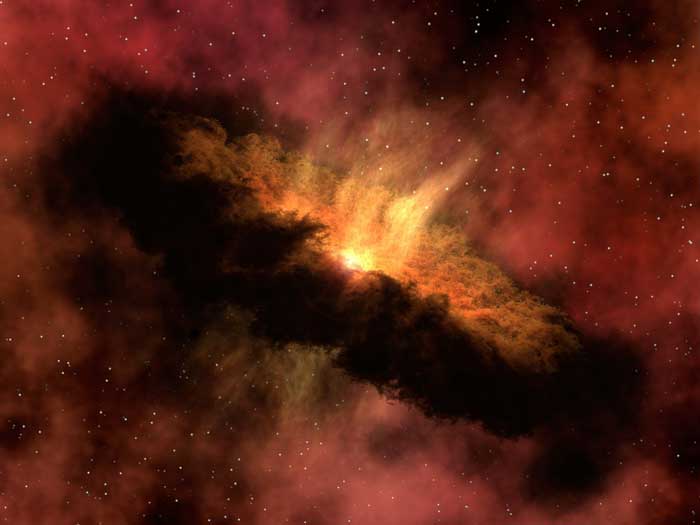 The age of our Sun is estimated to be 4.6 billion years, which means the Sun was formed that much ago. The formation of the Sun began when the molecules of hydrogen and Helium gases in a giant cloud began to collapse. The collapse of molecules occurred due to the gravitational force. When enough mass of the gases was compressed, the fusion reaction started and the Sun was born.
The age of our Sun is estimated to be 4.6 billion years, which means the Sun was formed that much ago. The formation of the Sun began when the molecules of hydrogen and Helium gases in a giant cloud began to collapse. The collapse of molecules occurred due to the gravitational force. When enough mass of the gases was compressed, the fusion reaction started and the Sun was born.
The size of the newly born Sun was much smaller and its brightness was less than today’s sun. Because, as the Sun ages, its size and brightness increases. Our Sun is considered to have passed half of its life.
Structure
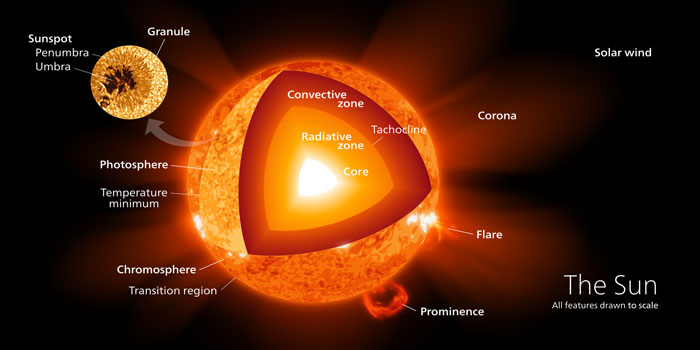 The Sun has a radius of 695,510 kilometers and has many layers that differ from each other due to various physical properties. But, the main layers of our Sun are core, radiative zone, tachocline, convective zone, photosphere, and Atmosphere.
The Sun has a radius of 695,510 kilometers and has many layers that differ from each other due to various physical properties. But, the main layers of our Sun are core, radiative zone, tachocline, convective zone, photosphere, and Atmosphere.
Let’s discuss these layers in more detail.
Core – The core is the vital layer of the Sun and any other star because this is the layer in which the energy is produced by the fusion reaction. The core occupies around 25% of the Sun’s radius and has a tremendous amount of pressure and temperature. The temperature of the Sun in this layer is around 15 million degrees Centigrade (or 27 million Fahrenheit).
Radiative Zone – Radiative zone begins after the core and occupies around 45% of the Sun’s radius. The Energy produced by the core transfer through this layer. The transfer of energy from this layer occurs by the method of radiation, instead of convection. It takes around 100,000 years for a photon to travel from this layer and reach the surface of the Sun.
Tachocline – Tachocline is a very thin layer and is simply a transition layer in which certain physical processes occur that separate radiative zone from the convective zone.
Convective zone – This layer of the sun extends from the tachocline layer and meets with the surface of the sun (the photosphere). The convective zone has a lower density as compared to the radiative zone, which makes it easier to transfer the Heat by convection.
Photosphere – This is the layer that is visible and is considered as the surface of the Sun. The Temperature here drops to 5,500 °C and radiation from this layer finally escapes the Sun. The thickness of the photosphere changes throughout the Sun and may change from 10 km to 100 km.
Atmosphere – Atmosphere is the layer that surrounds the surface of the Sun. It is composed of various other layers which include chromosphere, transition region, corona, and heliosphere. The atmosphere of the Sun can also be seen with naked eyes during a solar eclipse.
Composition
At the time of formation, the Sun was majorly made of hydrogen and a small amount of helium gas. But, since the Sun fuses hydrogen atoms to make helium atoms in a process called fusion. At the present time, the hydrogen accounts for 75% of the Sun, while helium is 23.8%. The remaining mass of the Sun contains other elements such as oxygen, iron, and carbon.
The fusion of Hydrogen into helium gas happens at the core of the Sun. The fusion reaction consumes hydrogen and produces helium which has increased the quantity of helium in the core of the Sun. It is estimated that newly born Sun may have 24% helium at the core, but now helium accounts for 60% of the core. Whereas, the hydrogen remains at 40%.
Facts
- It is estimated that, when the Sun will reach near its death in about 7 billion years, it will expand so much that it will gulp the orbit of our Earth.
- The sun along with whole solar system orbits around the Milky Way – much like planets around the Sun. It takes around 250 million years to complete one orbit around the center of the Milky Way.
- “UY Scuti” is the largest star in our observable universe. It is so big that if you replace this star with our sun, its diameter alone will cross the orbit of Jupiter; its radius is around 1700 times larger than our Sun’s radius.



